biomechanical principles + linear motion
1/69
There's no tags or description
Looks like no tags are added yet.
Name | Mastery | Learn | Test | Matching | Spaced |
|---|
No study sessions yet.
70 Terms
what is linear motion
motion in a straight or curved line with all body parts moving in the same direction at the same speed
explain how 100m sprinters and 200m sprinters use linear motion
100m sprinters travel with linear motion in a straight line during their race
200m sprinters travel with linear motion in a curved line during their race when running the bend
what is newtons first law of motion (the law of inertia)
an object will remain stationary or maintain motion in a straight line unless an external force acts upon the object
give an example of newtons first law of motion
high jumper runs in a curved line towards the bar and then changes their motion as they push off the floor and travel vertically to clear the bar
what is newtons second law of motion (law of acceleration)
force = mass x acceleration
the rate of change of momentum of a body is proportional to the force causing it, and the change takes place in the direction in which the force acts
give an example of newtons second law of motion
to provide acceleration at the seat of a race, the sprinters will have to apply a large force internally by contracting their gluteals, quadriceps and hamstrings as they drive forwards out of the starting blocks
what is newtons third law of motion (the law of action/reaction)
to every action, there is an equal and opposite reaction
give an example of newtons third law of motion
when a sprinter pushes into the starting blocks, the blocks exert an equal and opposite force onto the sprinter, allowing the sprinter to push off the blocks and accelerate
what is a scalar quantity
when measurements are described in terms of their size or magnitude
direction isn’t taken into account
what are all of the scalar quantities
speed
distance
mass
define speed
the rate of change of distance
how is speed calculated
speed = distance / time
define distance
the length of path a body follows when moving from the starting to finishing position
measured in meters
how is distance calculated
distance = speed x time
what graphs are used to show speed and distance
distance-time graphs
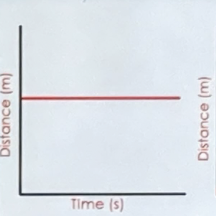
what does this graph state about a performer and give an example
the performer is stationary
e.g. a netballer taking a shot
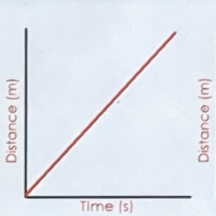
what does this graph state about a performer and give an example
the performer is in a constant state of motion
e.g. long distance running
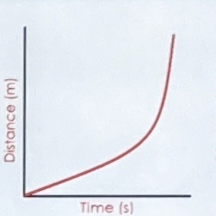
what does this graph state about a performer and give an example
the performer is accelerating
e.g. the start of a 100m sprint race
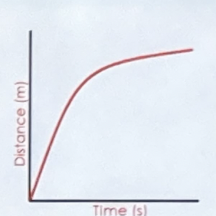
what does this graph state about a performer and give an example
the performer is decelerating
e.g. after a 100m sprinter has crossed the finish line
define mass
the quantity of matter a body possesses
measured in kg
what is the centre of mass
the point in the body at which the force of gravity can be thought to act
why do males have a higher centre of mass than women
males have broader shoulders
females have wider hips
there is more weight concentrated in these areas
what factors affect stability
Height of the centre of mass- lowering the centre of mass will increase stability
The position of the line of gravity- this should be central over the base of support to increase stability
Area of the base of support- the more contact points, the larger the base of support becomes and the more stable the body becomes
Mass of the performer- often the greater the mass, the more stability, due to increased inertia
explain the concept of centre of mass in relation to forces
centre of mass is the point on the body where gravity is thought to act upon
if a force is applied through the centre of mass this will lead to linear motion
if a force is applied outside the centre of mass this will lead to angular motion
what are the three components of a lever
fulcrum (joint)
effort (muscle/source of energy)
resistance (the weight to be moved)
what is mechanical advantage
when the effort arm is longer than the resistance arm
+ allows us to move a large load with little effort
- small range of motion
- small speed of movement
what is mechanical disadvantage
when the resistance arm is longer than the effort arm
+ large range of movement
+ fast speed of movement
- can’t lift heavy weight
draw and label a first class lever
no mechanical advantage
no mechanical disadvantage
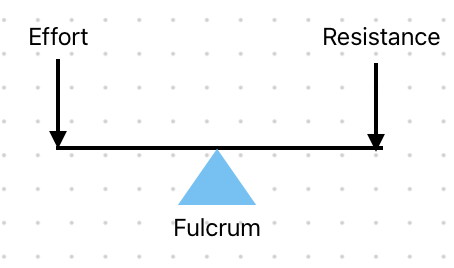
give examples of first class levers
extension at the elbow (tricep)
neck flexion and extension
draw and label a second class lever (easy wheelbarrow)
has MA
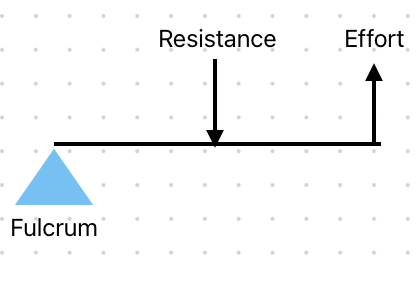
give examples of second class levers
plantar flexion at the ankle (gastrocnemius)
draw and label a third class lever (hard wheelbarrow)
has MD
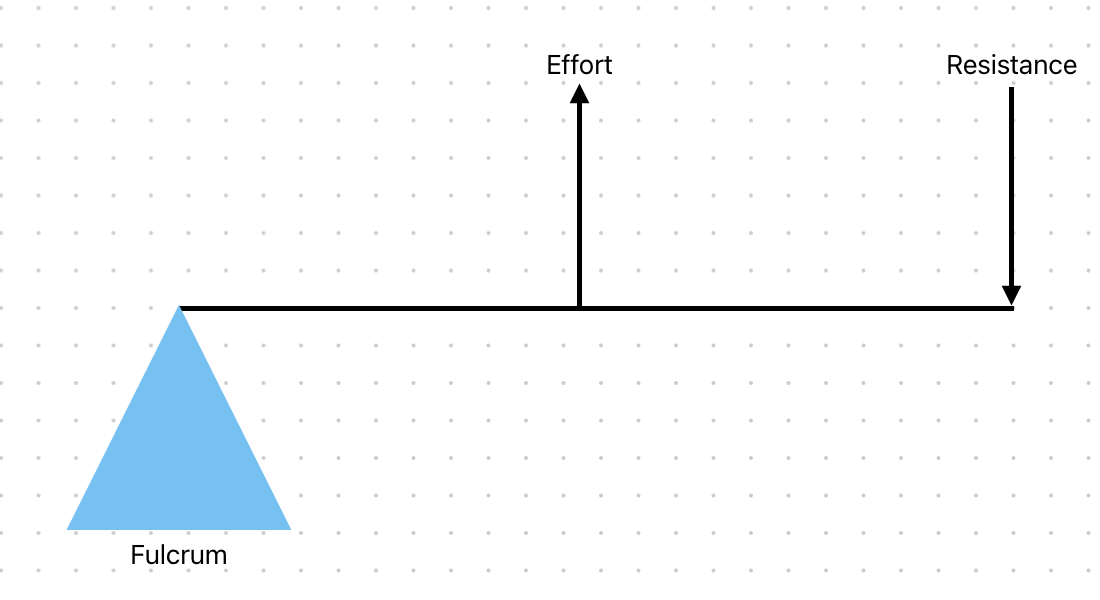
give examples of a third class lever
knee flexion and extension (quadricep and hamstring)
elbow flexion (bicep)
what are the two types of forces that can change a body’s state of motion during linear motion
internal forces
external forces
what internal forces can act upon a performer during linear motion
these forces come from within the body
when our skeletal muscles contract
what external forces can act upon a performer during linear motion
these forces come from outside the body
air resistance
weight (gravity)
friction
ground reaction force
what are the vertical and horizontal forces
horizontal- friction + air resistance
vertical- weight
what is weight and gravity
weight is a gravitational force that the earth exerts on a body, pulling it towards the centre of the earth/downwards
the greater the weight of the body, the greater the gravitational force exerted on the body is
weight is equal to the mass of the body, multiplied by the acceleration of the body due to gravity
draw a free body diagram showing the external forces
the length of the arrow reflects the magnitude/size of the force
longer = bigger force
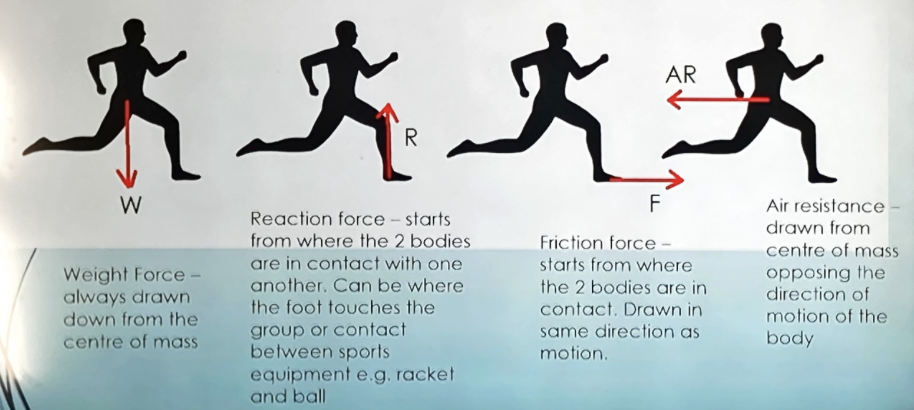
what is friction and what are the different types of friction
friction occurs between two surfaces and acts in the opposite direction to motion
there is static friction and sliding friction
what is static friction
occurs before an object starts to slide
the force exerted on one surface by the other when there is no motion between the two surfaces
what is sliding friction
when friction acts between two surfaces that are moving relative to each other, sliding friction occurs
how does the frictional force allow us to run
when the runners foot lands on the ground the foot is stationary due to static friction
as the body moves forwards over the foot and our foot is behind, sliding friction acts forwards, stopping the foot from sliding back, allowing the runner to push off
when we stride and the foot is in front of the body, sliding friction acts backwards to stop the foot moving forwards on the surface
what factors can affect friction
The surface characteristics of the two bodies in contact e.g. running spikes- maximise friction and therefore acceleration and minimises slipping
The temperature of the two surfaces in contact e.g. curling- sweeping the ice increases the temperature which reduces the friction between stone and ice, allowing the stone to travel further
Mass of the objects that are sliding- a larger mass = greater friction
what factors affect air resistance
The velocity of the moving body- the faster the performer moves, the greater the air resistance
The cross sectional area of the moving body- the larger the cross sectional area, the greater the air resistance e.g. cyclists crouching over the handle bars
The shape and surface characteristics of a moving body- streamlined shape results in less air resistance e.g. cyclist helmets
how can athletes become more streamlined to reduce air resistance
wear lycra cycling suits
shave body hair
wear full swimsuits
wear special helmets that are aerodynamic
bike or car has an aerofoil shape
how can the effects of internal and external forces be showed on vector diagrams
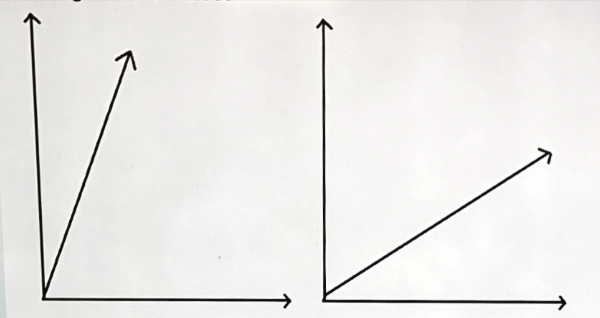
explain the vector diagram for a high jumper
in the high jump the performer uses a large amount of internal muscular force generated by the gluteals, quadriceps and gastrocnemius to achieve as much vertical displacement as possible to clear the bar
the relationship between the amount of vertical force and horizontal force provided by the muscles will lead towards the vertical component
the large vertical force and small horizontal force will result in a large trajectory
explain the vector diagram for a long jumper
in the long jump the performer uses a larger internal muscular force generated by the gluteals, quadriceps and gastrocnemius to achieve as much horizontal displacement as possible
the relationship between the vertical force and horizontal force provided by the muscles will lean towards the horizontal component
the large horizontal force and small vertical force will result in the long jumper being able to jump a further distance
what is a vector quantity
measurements are described in terms of their size/magnitude and direction
what are all of the different vector quantities
weight
displacement
velocity
acceleration
momentum
what is weight
weight is a gravitational force that the earth exerts on a body, pulling it towards the centre of the earth/downwards
measured in newtons (N)
how is weight calculated
weight (N) = mass (kg) x gravity (NM)
what is displacement
the shortest distance in a straight line between the starting and finishing point
measured in meters
what is velocity
the rate of change of displacement
measured in meters per second
how do you calculate velocity
velocity (m s-1) = displacement (meters) / time (seconds)
what is acceleration
the rate of change of velocity
measured in meters per second per second
how do you calculate acceleration
acceleration (m/s/s) = change in velocity (m/s) / time (s)
what is momentum
the product of the mass and velocity of an object
measured in kg m/s)
how do you calculate momentum
momentum (kg m/s) = mass (kg) x velocity (m/s)
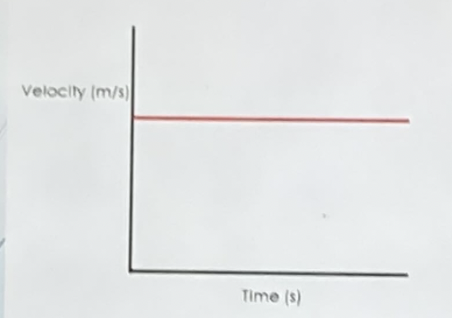
describe what is happening to a performer in the velocity time graph
the performer is moving a constant speed/velocity
describe what is happening to the performer in this velocity time graph
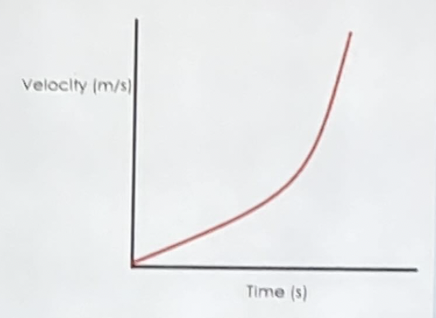
what is impulse
the time it takes for a force to be applied to an object or body
measured in newton seconds (Ns)
force x time
what does an increase in impulse cause
increase in impulse → increase in change of momentum → increase in change of velocity
increase in positive impulse → acceleration
increase in negative impulse → deceleration
how can impulse be increased
impulse = force x time
we can increase force by increasing muscular force that’s applied (recruit more and bigger motor units)
we can increase the time over which a force is applied (e.g. by following through on a throw or a punch)
how can a gymnast increase their impulse to have a safe, controlled landing and reduce injury
larger negative impulse
increase time over which the force is applied by flexing their hip, knee, and dorsi flexion of the ankle
this will decrease their momentum and velocity
→ reduced impact from landing on the joints (prevent injury)
→ more control over landing because velocity + momentum are lower
what is impulse represented by on a force-time graph
an area under a force-time graph
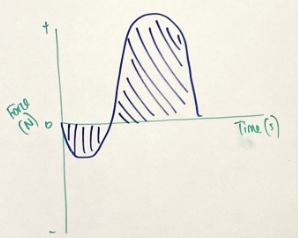
what part of a 100m race is this force-time graph showing
the start of the race
small negative impulse- the sprinter pushes off the blocks
large positive impulse- the sprinter is accelerating
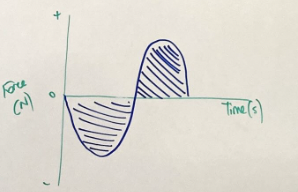
what part of a 100m race is this force-time graph showing
the middle of the race
negative and positive impulses are equal
negative impulse from when sprinters foot pushes off the ground (internal muscular force)
positive impulse from the ground reaction force (newtons third law of motion)
net impulse is 0 → sprinter is sprinting at a constant velocity

what part of a 100m race is this force-time graph showing
end of the race
small positive impulse- still going forwards
large negative impulse- decelerating